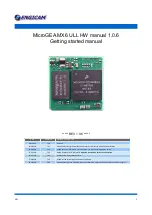
User's Manual l MB-SMARC-3 UM 0100 l © 2022, TQ-Systems GmbH
Page 3
1.9
Naming of Signals
A hash mark (#) at the end of the signal name indicates a low-active signal.
Example: RESET#
If a signal can switch between two functions and if this is noted in the name of the signal, the low-active function is marked with
a hash mark and shown at the end.
Example: C / D#
If a signal has multiple functions, the individual functions are separated by slashes when they are important for the wiring.
The identification of the individual functions follows the above conventions.
Example: WE2# / OE#
1.10
Further Applicable Documents / Presumed Knowledge
•
Specifications and manual of the product used:
These documents describe the service, functionality and special characteristics of the product used.
•
Specifications of the components used:
The manufacturer's specifications of the components used, for example CompactFlash cards, are to be taken note of.
They contain, if applicable, additional information that must be taken note of for safe and reliable operation.
These documents are stored at TQ-Systems GmbH.
•
Chip errata:
It is the user's responsibility to make sure all errata published by the manufacturer of each component are taken note of.
The manufacturer’s advice should be followed.
•
Software behaviour:
No warranty can be given, nor responsibility taken for any unexpected software behaviour due to deficient components.
•
General expertise:
Expertise in electrical engineering / computer engineering is required for the installation and the use of the device.
Implementation information for the carrier board design is provided in the SMARC Design Guide (2) maintained by the SGET.
This Carrier Design Guide includes a good guideline to design a SMARC carrier board.
It includes detailed information with schematics and detailed layout guidelines.
Please refer to the official SGET documentation for additional information (1), (2).




































